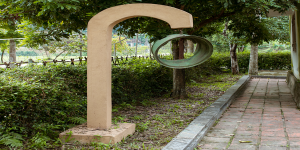
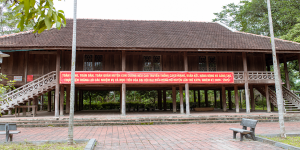
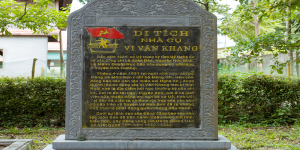
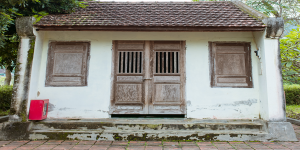
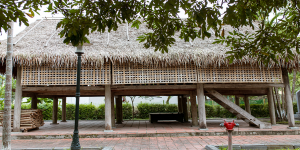
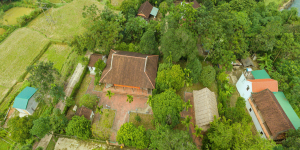
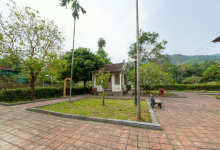
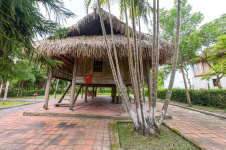
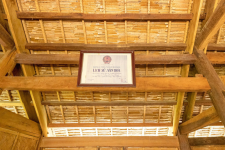
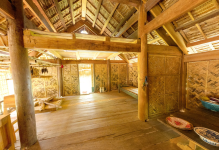
Camera tour
Price: Free
Time to visit a place: 120 phút
Open Time: 7:00 AM - Close Time: 6:00 PM
Address: Mon Son Village, Con Cuong District, Nghe An Province
MR. VI VAN KHANG'S HOUSE - CON CUONG
Mr. Vi Van Khang's house is located on the banks of the Giang River in Thai Hoa village, Mon Son commune, 20 km south of Con Cuong town. The house was built by Mr. Vi Van Khang's biological father in 1919 in the style of a traditional Thai stilt house on an area of about 1000m2. The house consists of 3 compartments, 2 halls, stairs up and down placed on both sides. The house's frame is made of wood, the roof is covered with palm leaves, the partition is made of bamboo, the floor is made of wood, with 12 columns of round boulders. Upstairs there is an altar, a reception area, a bedroom, a kitchen. The bedroom has a high floor slab for rice; when there was movement, the revolutionary soldiers went up there to hide. Dowstairs is for farming tools, raising cattle and poultry. Around is a large garden planted with fruit trees.
In early 1931, comrades Le Xuan Dao (Head of Finance Department of the Central Party Committee), Le Manh Duyet and Nguyen Huu Binh (Special Envoy of Nghe An Provincial Party Committee) went to Mon Son to build the revolutionary movement. Enlightened by Party cadres, Vi Van Khang enthusiastically participated in revolutionary activities. In a short time, he mobilized many young people such as Vi Van Hanh, Vi Van Qui, Vi Van Lam, Ha Van Hoa, Vi Van Noong, Vi Thi Lan, and Ha Van Thi to join the activity.
Thanks to that, the people of Mon Son became aware of the revolution, united and struggled. Many masses actively distributed leaflets, protected and nurtured Party cadres, etc.
In April 1931, the Mon Son Party cell was established at Mr. Vi Van Khang's house, consisting of 6 comrades, led by Vi Van Khang as Secretary. This is the first branch in the highlands of Nghe An. At this house, the Party base secretly printed documents and leaflets and distributed them throughout the villages. At night, people often gathered here to learn letters, cultural activities, and arts. Since then, the Mon Son movement moved into a new era of struggle. Mon Son became the contact point between the lowland revolution and the upland revolution, between the Kinh movement and the mountainous ethnic groups in Nghe An.
Thanks to the active activities of the Party cell, mass organizations such as the Red Farmer's Union, Red Self-Defense, etc. in Mon Son were born in turn; the revolutionary spirit of the masses was increasing day by day. On August 09, 1931, the Party cell led the people to protest, to the house of the Ba Uon Chief of Union (Chánh đoàn), to confiscate rice, money, cloth, and silver to distribute to poor families. Four days later, the French colonialists sent soldiers to Mon Son to suppress, arrest 30 people and 3 loyal party members (Vi Van Khang, Vi Van Hanh, Tran Ngan). The remaining party members withdrew into the forest to work in secret to rekindle the movement.
Mr. Vi Van Khang's house has been classified as a national revolutionary historical relic by the Ministry of Culture and Information by Decision No. 152/QD-BT dated January 25, 1994. Since 1994, the founding day of the Party cell has become an annual traditional cultural festival of the Mon Son people. Festival activities are held at Mr. Vi Van Khang's house and the Con Chua banyan tree.
Distance: 8.85 km
Distance: 12.75 km
Distance: 13.03 km
Distance: 13.11 km
Distance: 13.69 km
Distance: 13.88 km
Distance: 14.48 km
Distance: 14.77 km
Distance: 15.53 km
Distance: 15.54 km
Distance: 18.08 km
Distance: 18.78 km
Distance: 18.85 km
Distance: 19.02 km
Distance: 8.78 km
Distance: 13.41 km
Distance: 13.65 km
Distance: 13.73 km
Distance: 14.02 km
Distance: 14.30 km
Distance: 14.34 km
Distance: 14.71 km
Distance: 19.39 km
Distance: 0 m
Distance: 4.41 km
Distance: 8.01 km
Distance: 8.07 km
Distance: 8.90 km
Distance: 11.47 km
Distance: 12.11 km
Distance: 13.53 km
Distance: 13.53 km
Distance: 18.58 km
Distance: 19.74 km
Distance: 4.70 km
Distance: 12.30 km
Distance: 13.09 km
Distance: 13.91 km



0
No Comment!